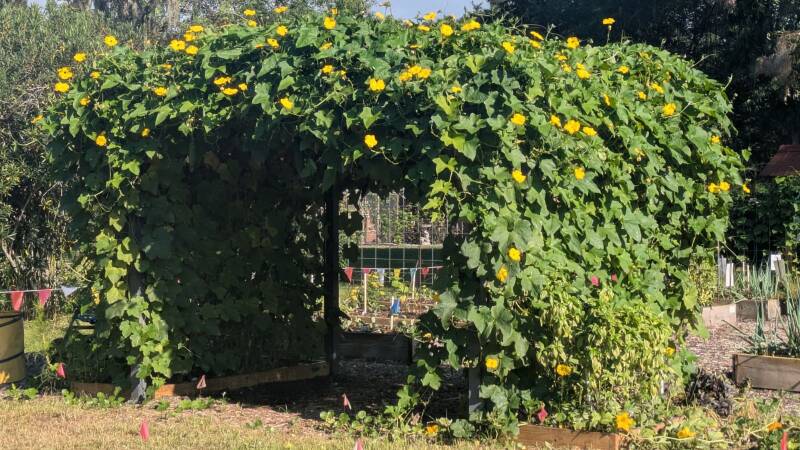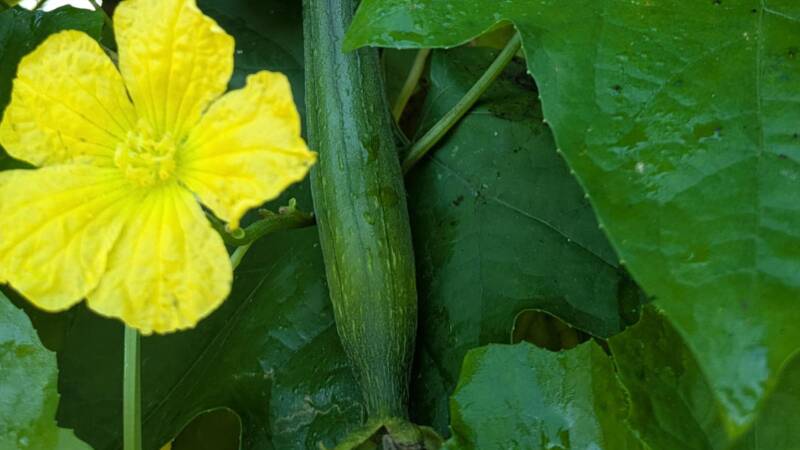
The Loofah Plant: Nature’s Sponge
The “sponge” you see in spas and shower caddies isn’t from the ocean at all. It comes from the loofah plant (also spelled luffa and sometimes loofa), a climbing gourd in the cucumber family. With a little patience and the right growing season, you can harvest your very own natural loofah—straight from the garden.
In this post, we’ll walk you through everything you need to know about growing loofah in Jacksonville: planting, harvesting, eating, and even turning it into a sponge.
Why Grow Loofah in Jax?
Jacksonville’s long, warm season is perfect for the loofah plant. These vines need about 150 days to mature. That’s a long season, but the payoff is worth it. Imagine picking a gourd, peeling back the skin, and finding a sponge inside ready for your bath or kitchen sink!
Bonus: before the gourd hardens, it’s also edible. Think tender squash with a zucchini-like flavor. So this crop is both practical and delicious.

How to Grow a Loofah Plant
If you’ve grown cucumbers or squash, you’re already halfway there. Here’s what works for us at Back to the Garden Jax:
- Planting time: Start seeds indoors in March or early April, then transplant after the last frost.
- Soil needs: Rich, well-drained soil with compost.
- Sun: Full sun is a must. These vines thrive in heat.
- Support: Provide a strong trellis or fence—the loofah plant can stretch 20 feet or more.
- Watering: Keep soil evenly moist, but not soggy.
Tips for Success
- Grow at least 3–4 plants, since not all may thrive.
- Give them room to sprawl, or prune side shoots to manage growth.
Be patient. Mature loofah sponges take time to develop.

When and How to Harvest
When you harvest depends on your goal:
- For eating: Pick while young (about 6 inches long). The flesh is still tender.
- For sponges: Wait until gourds turn yellow-brown and feel light and dry. Peel, shake out the seeds, rinse the fibers, and let them dry. And there you have it: your very own natural loofah.
Eating and Preparing Loofah in the Kitchen
Before it transforms into a sponge, the loofah plant produces gourds that are tender and tasty. In Asian and Indian kitchens, it’s a common vegetable.
Ways to cook it:
- Stir-Fry: Slice thin and cook with garlic, onion, and soy sauce.
- Curries & Soups: Peel, chop, and simmer to soak up flavor.
- Stuffed Loofah: Hollow out a young gourd, fill with rice or herbs, and bake.
- Simple Sauté: Olive oil, salt, pepper. Done in minutes.
Try this authentic loofah stir-fry recipe for inspiration.
How to Use Grown Loofah
Once your gourd dries into a sponge, the possibilities are endless:
- Bath & body: Gentle, natural exfoliation.
- Kitchen: Plastic-free scrubber for dishes.
- Crafts: Great for soap-making or creative DIY projects.
- Compost: At the end of its life, it returns to the soil.
For more inspiration, check out Mother Earth News on creative loofah uses.

Source: Wikimedia Commons
Why We Love Local Loofah
Most store-bought sponges are imported and treated with chemicals. Growing your own natural loofah here in Jacksonville means you know exactly how it was cultivated. You’re cutting waste, boosting your backyard ecosystem, and getting something useful out of the garden.
And honestly, how fun is it to say you grow your own bath sponges?
The Versatile Veggie
The loofah plant is one of our favorite “surprise” crops. We start with a seed, and end up with something that’s useful, sustainable, and edible.
At Back to the Garden Jax, we’re always looking for ways to bring healthy, local, and unique crops to our backyard for your next U-Pick harvest. Ready to give loofah a try? Harvest your next bath sponge—or stir-fry ingredient—and become a U-pick veggie garden member.

